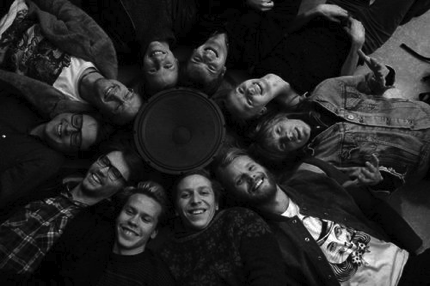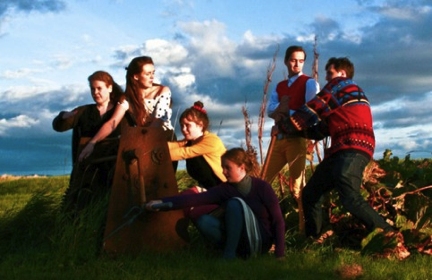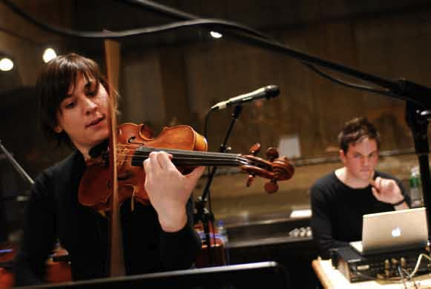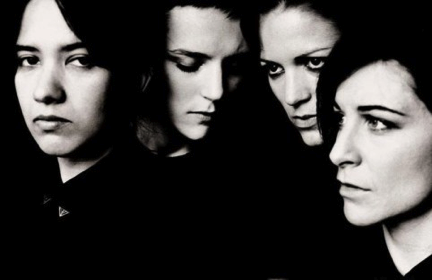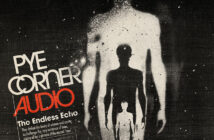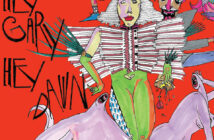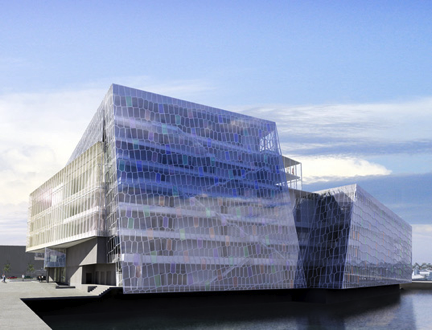
Harpa Concert Hall in ReykjavÃk
The 14th edition of the Iceland Airwaves Festival, which began in an aircraft hangar, is now mostly based in the magnificent Harpa Concert Hall on the shoreline of ReykjavÃk, a building which remained in construction after the 2008 financial meltdown, but was subsequently opened in 2011 and has become the base of the Iceland Symphony Orchestra. The ISO shares conductor Vladimir Ashkenazy, who is their “conductor laureate’ since he first conducted them in 1972, with the Sydney Symphony Orchestra. Harpa is a magnificent building made up of faceted oblong mirror surfaces which reflect all kinds of fragments of the environment, especially at night, and for the festival a miniature iceberg has been placed in one of its pools in the courtyard. A victim of its own success, Airwaves is now regularly sold out weeks in advance, and hosts over 7,000 people, taxing the accommodation capacity of ReykjavÃk’ hotels. Which has caused some controversy, especially since the Graffiti Garden, just off the main street, Laugavegur, which used to be a family-friendly site hosting impromptu summer concerts and hip hop jams, has now been turned into the site of another tourist hotel. Similarly Harpa is viewed by many locals as a white elephant, which needs to be paid off as soon as possible, hence its open policy towards rock music and Airwaves hipsters whom it tolerates rather more accommodatingly than the Sydney Opera House, with which it shares a similar atmosphere.
Iceland seems from the outside to have completely recovered from its economic meltdown in 2008, and “game over’ SUVs are back in evidence all around ReykjavÃk, although a recent issue of the English-language ReykjavÃk Grapevine commemorating the 5 year “collapsaversary’ suggests things are still far from rosy, even if economic growth has been restored and unemployment reduced. A left-wing government comprising the Social Democratic Alliance and the Left Green Party, and led for more than four years by the world’ first gay woman prime minister, Jóhanna Sigurðardóttir, steered the economy towards recovery, with Johanna famously saying “The Nordic countries are leading the way on women’s equality, recognizing women as equal citizens rather than commodities for sale’. But in May of this year the same coalition parties, Independence and Progressive, who led the country into economic collapse, were voted back into power, with PM Sigmundur DavÃð Gunnlaugsson, a man 33 years Jóhanna’ junior, and generally regarded as a bit of an idiot (at least be the people I know) . Household debt is still widespread, interest rates high, and as one Grapevine editorial states, “the small group of businessmen and bankers, who many think caused the crash, have lost jets and yachts, but are otherwise doing remarkably well’.
A couple of Airwaves events in the magnificent blood-red four-tier Harpa Eldborg auditorium require extra tickets, notably Kraftwerk’ final performance on the Sunday night, (ho-hum, but it is their first time in Iceland), and Ólofur Arnalds’ For Now I am Winter, with string quartet, electronics, soloist Arnór Dan Arnarson, a classically-trained opera singer who fronts the neo-punk rock group Agent Fresco, and the 90 piece ISO. A reduced version of this ensemble toured Australia in September and October, playing the Basement in Sydney. It turns out to be a triumph on its first performance in ReykjavÃk. The curtain-raiser was less impressive, a rather pointless reworking of Vivaldi’ Four Seasons by British composer Max Richter, both pieces conducted by André de Ridder, who also conducted the world premiere of For Now I Am Winter at the Barbican in London in March, and is steerings an extended European tour of the work in November. There are a few back projections, most notably of flurrying snowflakes, which remind me of listening to the piece in Hannover earlier this year with a friend, accompanied by almost vertical snowfall visible through the windows. But generally the piece is quite contained in its dramatic moments, with Arnason’ falsetto English vocals slightly reminiscent of Jonsà from Sigur Rós, and Arnalds performs an encore on solo piano which is dedicated to his family in the audience and the recent loss of his grandmother, which gives the whole event a decidedly local focus, after beginning with a recording of the audience singing an extended note. Arnalds’ introductory explanations switch between Icelandic and English, but it is clear this performance is primarily for the Icelandic audience, despite its English lyrics, and there is a sustained standing ovation.

Ólofur Arnald’ For Now I Am Winter at Harpa
After this, it’s a bit of a jolt to see Robert Forster of the Go Betweens, the only Australian guest at Airwaves, in an acoustic set included in a new “AirWords’ event showcasing Icelandic and overseas poetry, organised by prominent Icelandic writer Andri Snaer Magnason. Maganson is the author of the worldwide best-seller Dreamland, about the selling off of huge slices of Iceland for development into aluminium smelters, which had a preface by Björk, and was subsequently made into a film with music by Valgeir Sigurðsson and other Bedroom Community artists, including Australian Ben Frost (see my interview in Cyclic Defrost 32/
More about BC later.) Forster seems an odd choice for a poetry event, but he fills the smallish Kaldalón auditorium to overflowing with a very appreciative audience, singing more recent Go Betweens songs such as “Surfing Magazines’, which strikes a bizarre note with its references to Bells Beach and Byron Bay, and in which he gets the audience to sing along with the “Da da’ chorus, and other autobiographical songs such as “Born to a Family’ from Oceans Apart, finishing strongly with “Here Comes a City’. He tells us that friends and family in Australia got excited when they heard he was coming to Iceland, unlike their usual ho-hum response to his travels to other places in Europe. Magnason, who follows him, gets a far smaller audience, but regales us first with a sample of the ancient Icelandic form of rÃmur, then with his English language poetry project inspired by a local supermarket, Bonus, whose symbol is a pink pig, and reads a chapter from last year’ sci-fi novel LoveStar. Other poets and writers in this session include Sjón, a poet, novelist and former Björk collaborator, who also wrote the splatter movie ReykjavÃk Whale Watching Massacre, and was a guest at the Sydney Writers’ Festival last year.
Thursday 1st November is Halloween, and at a meeting at the RÚV national broadcasting company earlier in the day I’m surprised to see a kid dressed as a US cop playing with other kids in similarly American costumes, which suggests it is a holiday here too. Ira Kaplan of Yo La Tengo, who headlines the day – their first time in Iceland in their 29 year history – comments on this, and there are a few hipsters in the audience embellished with carnival masks, feathers and the like, but hardly on a mass scale. YLT get off to a slow start with a suitably reverential cover of Lou Reed’ early Velvet Underground song “I’m Set Free’, followed by Georgia Hubley and James McNew swapping roles on drums and bass, a song by Georgia, and Mc New’ hilarious falsetto rendition of “Mr. Tough’. Then the tempo picks up, Kaplan starts his blitzkrieg guitar pyrotechnics, and strangely there is a steady exodus among the audience from the relatively small Silfurberg room, as Kaplan waves his guitar around in the air, lays it down flat, slashes at it, twists and tortures it, while Hubley beats away impassively and McNew spends the last 15 minutes playing the same bass line, zombie like, as things disintegrate around him. It’s a triumphantly blistering and exhilarating 90 minute performance, but the room is barely more than half full by the time it finishes at 1am. Since the demise of Sonic Youth, YLT has assumed the mantle of most adventurous US rock group.
The previous evening the crowds had been impossibly large for what was by most accounts a dud performance in the same room by Emiliana Torrini, overlapping with FM Belfast’s set in the Norðurljós room next door, which was hosting a showcase by the local Records Records label, so it seems there’ a definite preference for Icelandic performers at the festival, probably due to a discernible majority of locals here. Other Icelandic groups playing to packed houses in Harpa upstairs venues include Samaris, two bridally costumed teenaged women sprayed in glitter, one on clarinet, the other on sub-Björk vocals, positioned either side of a male electronica DJ. I overheard an Australian woman in the audience describe the singer, JófrÃður Ãkadóttir, whose breathy vocals are in Icelandic, and apparently based on 19th century Icelandic poems, as “ethereal’, which fits the Icelandic stereotype of many performers. In fact it is the word used in the group’ press release. Mammut consist of a rather large woman in a caftan fronting a band which includes two female guitarists who look slightly awkward on stage. The press release describes the vocals as “a collection of tics and gasps and shrieks’, which suggests another sub-Björk performer. Bloodgroup are an early 80s vintage electro outfit whom it is difficult to make out in the dark, although their very mobile anonymity contains a female singer and the male member of the electro duo Byrta from the neighbouring Faroe Islands, situated half way between Iceland and Norway, who also feature singer Guðrið Hansdóttir, who sings in her native language, and have their own spot in the festival. Bloodgroup are pleasant enough, but sing in English, have released 3 albums, have record deals in the UK and the US, which suggests they are creating a buzz. I’m reminded of a comment by an Icelandic musicologist in a short documentary on Airwaves 2011 shown on the flight here (Iceland Air of course) who says that at the moment, it is very difficult for Icelandic musicians to fail. A big disappointment for me is Singapore Sling, an established group who have been around since the beginning of the century, have released 5 albums, and have a female bassist. They are not on the official program, but they do an off-venue gig at 12 Tonar records in Harpa, and sound pretty terrible.
Obja Rasta, Iceland’ second reggae group, formed in 2009, after the groundbreaking Hjálmar, a folk-reggae group formed in 2004, with six albums under its belt, all in Icelandic, one recorded in Jamaica. An 11 piece outfit with dubmaster, trumpet, sax, keyboards, 3 guitars, drums and a female euphonium and melodica player, who claim to be influenced by ancient Icelandic poetry, they have just released their second album, Friður (Peace). They emphasise the crowd-pleasing, rhythmic, fun aspects of reggae, and give a highly enjoyable performance. Their singer calls himself Jolly Good, they alternate English and Icelandic songs, and have had two number 1 singles in the Icelandic charts.
Unofficial “Off-Venue’ events have proliferated at Airwaves, and take place at numerous bars, cafes, shops and art galleries around the city. This year there are 600 shows at 48 different venues, far outnumbering the 120 official shows in 12 venues. This means that you are likely to hear some terrible bands who are just starting out. One example was a group called Saytan (yes, there is a pun) who played in the English pub, which is actually not a bad location if you like Guinness, and seems to be mostly frequented by Icelanders. They already have Christmas decorations up, and on football nights they pull down a series of about six screens around the room and project two games at once. When a goal is scored, a bell is rung.
A complicating factor is that many groups and artists appear several times, such as Apparat Organ Quartet, who have announced 10 shows at a combination of on- and off-venues. For their first show at the 12 Tonar record shop in Harpa they are missing their drummer, whose partner is having a baby, so they produce “soothing sounds for the baby’ on their three analogue organs. An even more complicating factor is that, typically in the ReykyavÃk music scene, a number of musicians play in several different bands. In 2011 Ragnhildur Gunarsdóttir, female trumpeter with Of Monsters and Men, set some kind of record by playing 30 shows, including 3 headlining acts on the Saturday night. The Reykjavik music scene is nothing if not compact and interconnected, as well as multi-genred. A Grapevine article profiles drummer Magnús Trygvason Eliassen, aka MaggÃ, who plays with Amiina, Sin Fang, Moses Hightower and a number of other groups. Last year he played 24 shows, shifting venues in foul weather over the 5-day festival, but this year he is scheduled for only 9 shows in 7 bands, partly because he has to miss the first two days. His gig with Amiina this year in the overflowing Gamla BÃó, an elegant former cinema now used by the Icelandic National Theatre, is unfortunately cut short, and they don’ play their last number, which is almost like coitus interruptus for this lovely, mostly female group who started in the late 1990s as a classical string quartet, like so many local musicians here. After playing and recording with Sigur Ros, they went their own way, and last year released a gorgeous-looking and -sounding new EP, The Lighthouse Project, recorded “live’ by the ubiquitous Ben Frost. The opening track is called “Perth’, which suggests Frosts is not the only Australian connection. Eliassen assumes speaking duties for the band, as he did when they toured Australia in 2012, questioning whether audience members with mobile phone cameras actually watch the whole concert through them. The group swaps instruments continually, with the musical saw getting a good working out, along with an accordion, bowed zylophones, glockenspiel, a couple of violins and a “gideon harp’, a small zither. Despite being truncated, this is one of the festival highlights.
One Off-Venue gig which attracted a huge audience was Bedroom Community’ showcase in the Lutheran HallgrimÃnskirkja church which at 73 metres towers over the top of the city, and in a sense opened proceedings on Wednesday October 30, although there had been smaller gigs in places such as Lucky Records since the previous Monday. This was a two hour event featuring British organist James McVinnie, a recent recruit to the label who recorded an album of Nico Muhly organ pieces Cycles, last year, US viola player Nadia Sirota, who has collaborated with a number of BC artists and released a solo album on the label, Baroque, this year, along with label founder Valgeir Sigurðsson, Ben Frost, DanÃel Bjarnason, the Kammersveit ReykjavÃkur Quartett and members of the ReykjavÃk Sinfonia, who were effectively another string quartet. McVinnie led off with Messiaen’ “Apparition of the Eternal Church’, an appropriate opening that exploited the range of the boomingly resonant church organ and scared off a few punters expecting less classical fare. The ReykjavÃk tourist website describes the pipe organ as “designed and constructed by the German organ builder Johannes Klais of Bonn. Standing tall at an impressive 15m and weighing a remarkable 25 tons, this mechanical action organ is driven by four manuals and a pedal, 102 ranks, 72 stops and 5275 pipes, all designed to reproduce powerful notes capable of filling the huge and holy space with a range of tones – from the dulcet to the dramatic’. Then Sirota joined McVinnie for Arvo Pärt’s “Pari Intervallo’, a typically mininalist but melodic piece by the Estonian composer, before McVinnie played two organ pieces by BC alumnus Nico Muhly. By this stage there was a constant toing and froing in the side aisles of the church, people leaving and arriving like shuffling pilgrims, which occasionally made it hard to concentrate on the music. Sigurðsson’ “Big Reveal – The Crumbling’, from his most recent album, featured Sirota and the Kammersveit Quartet with the composer on piano, and electronics by Frost which popped like fireworks, then we were back to the organ for another Muhly piece. Frost went into action with the Sinfonia on an instrumental suite from his “Wasp Factory’, a recent music theatre piece based on the cult novel about a teenage psychopathic killer by Iain Banks, directed by Frost in London with the same Sinfonia members and crackling electronics at the Royal Opera House in October.
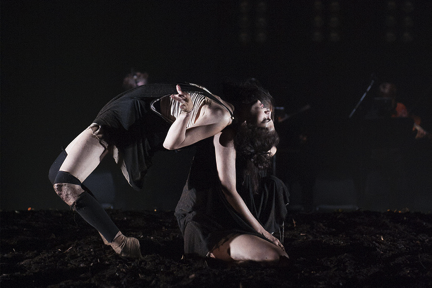
Mariam Wallentin and Jördis Richter in Ben Frost’s production of The Wasp Factory © ROH / Stephen Cummiskey 2013
Then it was back to McVinnie at the organ, for another Muhly piece, followed by a rousing finale of the Toccata by Patrick Gowers, a contemporary English composer known for his music for Sherlock Holmes films. Some might have questioned the number of organ works, but they certainly made use of the powerful church organ and the resonance the high steeple provided, even if some audience members may have been perplexed by the all-classical repertoire. A later concert in the church featuring Múm has to turn the huge queue away as there is no more room. I catch Múm later at an off-venue site at the KEX hostel, which is situated right on the edge of the water overlooking snow-capped mountains. It’s a lovely spot, but I can’ see the band for the people, and they play only four songs, finishing after twenty minutes, despite a vociferous crowd urging for more. In the absence of Björk and Sigur Rós, who are touring, they are the most international of Icelandic bands on display, along with Amiina.

HallgrimÃnskirkja, foregrounded by the statue of Leifur Eiriksson, the first European to discover America in the 11th century, designed by Alexander Calder, a gift from the US government in 1930 to commemorate the 1,000 anniversary of Iceland’s “world first’s parliament at Þingvellir in 930 AD.
The next day Sirota gave a solo performance in Kaldalón, the most comfortable venue in Harpa, as it is raked with seating, along with Valgeir and Bjarnasson, who shared duties on keyboards. Opening with another piece by Nico Muhly from her album Baroque, she also played a piece from Valgeir’ latest album Architecture of Loss. She revealed her first contact with Bjarnasson had been at a world viola congress in ReykjavÃk in 2004, for which the composer wrote a piece for 12 violas, which she proceeds to reproduce in a version for viola solo, computer and keyboards. Dressed in black, with a black fringe, she has a distinctive and slightly impish presence, and a masterly relation with her instrument.
She reappears later in the evening in the same venue, which Bjarnason refers to as “the dungeon’, with the ReykjavÃk Sinfonia, a double bass player and two percussionists with vibraphones and an array of other instruments, to play a series of pieces from Bjarnason’ last album, Over Light Earth, along with other BC alumni, including James McVinnie on second keyboards. The pieces swell, maintaining an intense interaction between strings, keyboards and percussion. The finale adds gothic Swedish singer Mariom the Believer, lugubrious in a black shawl, another BC associate, who has just dashed down from a gig at the Gamla BÃó, proving it is not just Icelandic musicians who perform in multiple contexts.
One performer who I have been dying to see live is the Faroese Eivør (Eyðvør) Palsdóttir, who is to the tiny Faroe Islands what Björk used to be to Iceland, and whose rivetting performances of songs like “MÃn Móðir’ (Faroes My Mother) and “Tröllabundin’ (Spellbound) on YouTube are a sight to behold, with her beating a Nordic skin drum like a Viking and exuding an earthy tribal voice and appearance which is utterly thrilling. Both these war horses were performed while she was still a teenager, and alas those days are gone. Now based in Denmark, her last album, Room, was entirely in English, with bland song titles like “True Love’, as she has been groomed for the international (which usually means US) market. The Faroes have their own three-day music festival, the G! festival, and has been going since 2004, held in the village of Syðrugøta, Eivor’ birthplace, which has a population of 400. It attracts more overseas than local artists, and in 2006 Eivør was welcomed home from Iceland as the “Queen of Faroese music’. She also appeared in the Icelandic music film Screaming Masterpiece, but with no mention of her origins. Tonight she’ wearing a gorgeous floral dress, and sporting an electric as well as an acoustic guitar, and she sings half a dozen songs from her new album, plus one song in Icelandic. She explains afterwards that there are slippages in her Icelandic into Faroese, which she says “sounds bit like drunken Icelandic’. Singing into two microphones, one producing a slight echo to her gorgeous wordless vocalisations, some in extremely high registers, which constitute the most exciting part of her singing, it’s easy to forgive her for the English lyrics, and no Faroese. She is able to transform the most banal language into absolute beauty. I realise I’m showing my exoticist bias – there’ a word for it here, “Borealism’, from the aurora borealis, which is currently going through the same process of exoticisation as Orientalism did in the West. Her voice is so thrilling and dazzling it’s almost impossible to compare her to anyone except perhaps early Joan Baez, and live she is so much more stunning and exhilarating than on record. The setting is apt too, the wooden Ãdno building, a restaurant and theatre built in 1897, right beside what is known in ReykjavÃk as “the pond’, which has already iced over despite being full of ducks and swans.

Eyðvør Palsdóttir in more tribal mode
After Eivor, it’s quite a drastic change to the all-female English neo-punk Savages, who are headlining in the Reykjavik Art Museum. One thing is for sure at this Airwaves, women rule in Ultima Thule. Never have I seen so many women performers in a festival lineup. And that’s not counting the huge number I have missed. It not only reflects the large number of female Icelandic musicians, but hopefully also a developing international tend. Savages, who perhaps not coincidentally share a manager with Sigur Rós, have created one of the biggest-ever buzzes for this year’ debut album Silence Yourself. They are a no-nonsense bunch of women, calling for the world to shut up, and their website includes a number of manifestos, including “Silence Your Phones’, which just might contain a message to all the hordes who photograph and film performances and text their friends during their music. From their singer Jehnny Beth’ French accent, slightly reminiscent of Siouxse, P.J.Harvey, Patti Smith and the Slits at their fiercest, to their drummer Fay Milton’ furious beat, Ayse Hassan’ tight basslines, and guiarist Gemma Thompson’ nicely under-stated licks, they add up to a very expert outfit who it is hard to believe have just been nominated for the Mercury Prize on the strength of a single and an album. While their intensity could be labelled retro-post-punk, they do not disappoint tonight, producing a blistering performance of the album over 90 minutes, including a ten-minute finale called “Don’ Let the Bastards Grind You Down’. The audience are wildly appreciative, the music is totally energising and engaging, and it’s a fitting end to a very busy Saturday night. They are touring Australia in February.
On Sunday I’m so burned out I spend most of the day sleeping, despite the glorious sunny weather that has prevailed throughout the festival, apart from a couple of furious gusts of wind in the first couple of days. The temperature has hovered around 3 degrees, the iceberg has almost melted, and I managed to make it down to the port for a special screening of Bedroom Community’ documentary film held on what probably used to be a whaling boat, but is now the museum-office of a whale watching company. It’s an appropriate setting, as the film is about BC’ 2011 Whale Watching Tour, and includes footage of a complete concert held at the ReykjavÃk National Theatre, with the opening section of Valgeir’ soundtrack from the film Dreamland, a couple of weird banjo-accompanied songs by Sam Amidon, including the glitched-up Icelandic folksong, “Grýlukvæði‘, about a greedy hag who comes to devour naughty children, which seems to be a metaphor for the heavy duty machinery devouring the land shown in the film. The concert also includes pieces from Frost’s Theory of Machines, and showcases most of the Bedroom crew, including Muhly, Sirota and Valgeir. But it’s cold and dark in the hold where the screening’ taken place, it fills up with people making air hard to come by, and I call it a day.
Coinciding with Airwaves is the publication of a new book in English about Icelandic pop and rock since the 1950s, Blue Eyed Pop (the title of a song by the Sugarcubes, commemorated this year with an exhibition of “lost’s photographs). It’s the first book on the subject in English (the author has already written two in Icelandic, and this is a shortened version of the second) by local music scene maverick Dr. Gunni (Gunnar Lárus Hjálmarsson), who is himself a bassist and vocalist, sometime poet, radio DJ, TV pop quiz master, Eurovision finalist, children’ entertainer, and contributor to the Grapevine. It’s lavishly illustrated, including photos of Björk driving a tractor, Sigur Rós when they were long-haired hippies, and Jónsi in drag. Starting in 1836 when a hurdy gurdy and wax cylinder were imported from Denmark, it finishes in 2013 with the latest singer-songwriter sensation Ãsgeir Trausti, winner of 2012 Icelandic album of the year and the most recent signing to One Little Indian. No index unfortunately, as it’s not intended to be scholarly, and strictly rock, pop and electronica, but more than enough to satisfy one’ curiosity. A musical companion with some unfamiliar songs can be found here and an interview with the author and extract from the book can be found here.
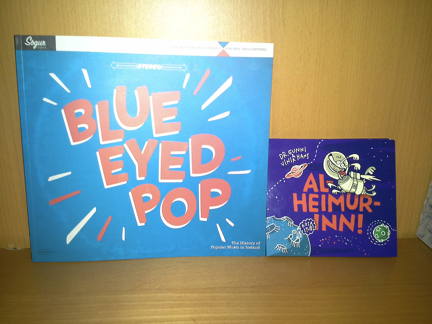
Blue Eyed Pop, along with Dr Gunni’ latest album “The Universe‘ for children “contains heaps of fun for families, including the all time summer hit “Happiest dog in the world”‘ (video). (Warning, contains farting).
According to his own polls, Dr Gunni claims the best Icelandic album of all time is Sigur Rós’1999 second album, Ãgætis byrjun (“A Good Beginning’ but not their beginning), followed by Björk’ 1993 Debut (which was of course not her debut) then a series of 13 albums almost completely unknown outside Iceland, until we get to Björk’ Homogenic at no. 15. It’s a cliché to say tip of the iceberg, but there remain far more musicians celebrated in Iceland than there are in the world outside. Troubadours Megas, Mugison, Bubbi Morthens, 70s prog rock groups Trúbrot and Þursaflokkurrin, cabaret-satirists Stuðmenn, who have toured China, Germany and Russia, and played the Royal Albert Hall in 2005, Utangarðsmenn (Bubbi’ early 80′ reggae-punk band, the Outsiders?), anyone? Many of these might deserve just as much recognition. Meanwhile Airwaves has plenty of musical resources to draw on, and can afford to keep their majority of Icelandic performers.
Tony Mitchell

